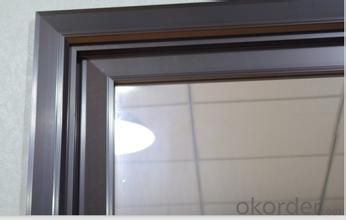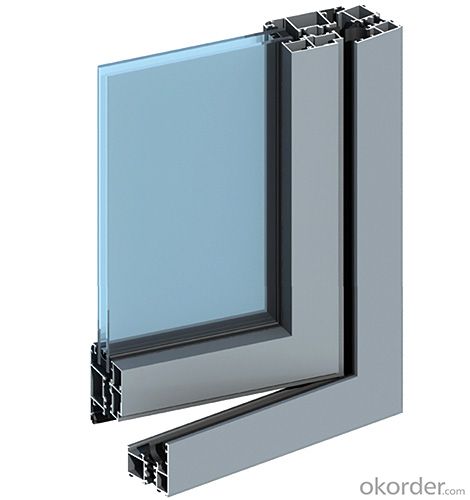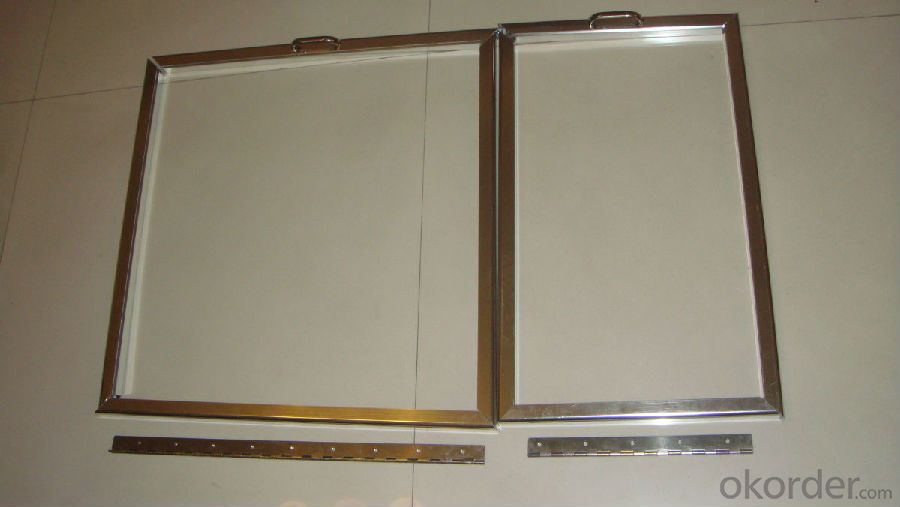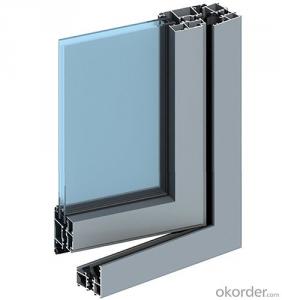Mill Finished Aluminium Profiles for Door Frames
- Loading Port:
- Shanghai
- Payment Terms:
- TT OR LC
- Min Order Qty:
- 5 m.t.
- Supply Capability:
- 1000 m.t./month
OKorder Service Pledge
OKorder Financial Service
You Might Also Like
Item specifice
1. Structure of Mill Finished Aluminium Profiles for Door Frames Description
Mill Finished Aluminium Profiles for Door Frames is one semi-finished aluminium material. The alloy AA1050 is widly used in building, industry ect. Its weight is much lower than steel. So many customers choosed aluminium material instead of steel.
2. Specification of Mill Finished Aluminium Profiles for Door Frames
Mill Finished Aluminium Profiles for Doors Frames | |
Main Specification | |
Alloy | AA1xxx (AA1050, AA1060, AA1070, AA1100 etc.) |
AA3xxx (AA3003, AA3004, AA3005, AA3105 etc.) | |
AA5xxx, AA6XXX (AA5052,AA5083, AA5754, AA6061, AA6062 etc.) | |
AA8xxx(AA8011, AA8006 etc.) | |
Temper | H14,H16, H18, H22, H24, H26, H32,O/F, T4, T6, T651 |
Thickmess | 0.01mm-100mm |
Width | 30mm-1700mm |
Standard | GB/T 3880-2006/ASTM |
Special specification is available on customer's requirement | |
3. Application of Mill Finished Aluminium Profiles for Door Frames
(1).Interior: wall cladding, ceilings, bathrooms, kitchens and balconies, shutters, doors...
(2).Exterior: wall cladding, facades, roofing, canopies, tunnels,column covers , renovations...
(3).Advertisement: display platforms, signboards, fascia, shop fronts...
4. Feature of Mill Finished Aluminium Profiles for Door Frames
Surfact Quality :
Be free from Oil Stain, Dent, Inclusion, Scratches, Stain, Oxide Dicoloration, Breaks, Corrosion, Roll Marks, Dirt Streaks and other defect which will interfere with use,
Mechenical Property:
Chemical Composite and Mechanical Property
5. Certificate of Mill Finished Aluminium Profiles for Door Frames
SGS and ROHS(if client request, paid by client), MTC(plant provided), Certificate of Origin(FORM A, FORM E, CO), Bureau Veritas and SGS (if client request, paid by client), CIQS certificate
6. Image of Mill Finished Aluminium Profiles for Door Frames



7. Package and shipping of Mill Finished Aluminium Profiles for Door Frames
First, plastic cloth with drying agent inside; Second, Pearl Wool ; Third, wooden cases with dry agent , fumigation wooden pallets, aluminum surface could cover blue PVC film
8. FAQ
1) What is the delivery time?
Depends on actual order, around 20 to 35 days
2) What is the QC system:
We have QC staff of 20 persons and advanced equipment, each production is with MTC traced from Aluminum ingot lot.
3) What market do you mainly sell to?
Australia, America, Asia, Middle East, Western Europe, Africa etc
- Q:Can aluminum profiles be used for retail displays?
- Yes, aluminum profiles can be used for retail displays. Aluminum profiles are versatile and can be customized to meet various design requirements. They are lightweight yet strong, making them ideal for creating durable and long-lasting retail displays. Additionally, aluminum profiles can be easily shaped, cut, and assembled to create unique and eye-catching displays. They can also be powder-coated or anodized to achieve different colors and finishes, enhancing the aesthetics of the retail space. Furthermore, aluminum profiles can be easily integrated with other materials such as glass, acrylic, or wood to create a multi-material display. Overall, the flexibility, durability, and aesthetic appeal of aluminum profiles make them a great choice for retail displays.
- Q:How do aluminum profiles perform in terms of static electricity discharge?
- Aluminum profiles have excellent static electricity discharge properties. Due to their high electrical conductivity, aluminum profiles are effective in dissipating static charges that may build up on their surface. This helps to prevent the accumulation of static electricity, which is particularly important in industries where electrostatic discharge can cause damage to sensitive electronic components or pose a risk to safety. The conductivity of aluminum profiles allows for the easy grounding of any static charges, ensuring a safe working environment. Additionally, aluminum profiles are often used in the construction of ESD (electrostatic discharge) protective equipment and structures, further highlighting their effectiveness in managing static electricity. Overall, aluminum profiles are highly reliable in terms of static electricity discharge, making them a preferred choice in various industries where static control is necessary.
- Q:Are aluminum profiles suitable for playground equipment?
- Yes, aluminum profiles are suitable for playground equipment. Aluminum is a lightweight and durable material that is commonly used in various industries, including playground equipment manufacturing. It is known for its strength and resistance to corrosion, making it suitable for outdoor applications. Aluminum profiles provide structural stability and can withstand the weight and forces exerted during play. Additionally, aluminum is non-toxic and does not rust, ensuring the safety and longevity of the playground equipment. The versatility of aluminum allows for the creation of various shapes and designs, providing endless possibilities for innovative and attractive playground structures. Overall, aluminum profiles are a suitable choice for playground equipment due to their strength, durability, and safety features.
- Q:What are the water resistance properties of aluminum profiles?
- The water resistance properties of aluminum profiles are exceptional. Aluminum itself has inherent resistance to corrosion, and when properly coated or anodized, it becomes even more resistant to water damage. Through the coating or anodization process, a protective layer forms on the aluminum surface, acting as a barrier against water penetration. Aluminum profiles find widespread use in various applications that involve exposure to water, such as windows, doors, and outdoor structures. Thanks to their water resistance properties, they can withstand moisture, rain, and humidity without deteriorating or rusting. Moreover, aluminum profiles have the advantage of being lightweight, making them ideal for water-related environments like marine applications. Despite their lightweight nature, they offer high strength and durability, enabling them to endure the harsh conditions associated with water contact. To summarize, aluminum profiles possess excellent water resistance due to their natural corrosion resistance and the protective coatings or anodization they undergo. This makes them a reliable choice for applications expecting water exposure, ensuring long-lasting performance with minimal maintenance needs.
- Q:What are the durability characteristics of aluminum profiles?
- Aluminum profiles are known for their exceptional durability characteristics. Due to the inherent properties of aluminum, such as its corrosion resistance, lightweight nature, and high strength-to-weight ratio, aluminum profiles are highly durable and long-lasting. One of the key durability characteristics of aluminum profiles is their resistance to corrosion. Aluminum naturally forms a thin oxide layer on its surface, which acts as a protective barrier against rust and other forms of corrosion. This makes aluminum profiles suitable for outdoor applications where they are exposed to harsh environmental conditions, such as rain, snow, and UV radiation. Additionally, aluminum profiles are able to withstand extreme temperatures without compromising their structural integrity. They have a high melting point and can resist thermal expansion and contraction, making them ideal for use in environments with fluctuating temperatures. Another important aspect of the durability of aluminum profiles is their strength. Despite being lightweight, aluminum is incredibly strong and can withstand heavy loads and impacts. This strength-to-weight ratio makes aluminum profiles a popular choice in various industries, including construction, automotive, and aerospace. Furthermore, aluminum profiles are highly resistant to wear and tear. They have excellent resistance to abrasion and can maintain their structural integrity even after prolonged use. This makes them suitable for applications that require long-term durability, such as window frames, door frames, and structural components. In summary, aluminum profiles possess remarkable durability characteristics due to their corrosion resistance, lightweight nature, high strength-to-weight ratio, thermal stability, and resistance to wear and tear. These qualities make them a reliable choice for a wide range of applications, ensuring their longevity and performance over time.
- Q:What are the different machining options available for aluminum profiles?
- There are several machining options available for aluminum profiles, depending on the desired outcome and the specific requirements of the project. 1. Milling: Milling is a widely used technique for cutting and shaping aluminum profiles. It involves removing material from the workpiece using a rotating cutter. This process can create complex shapes and features such as slots, pockets, and contours. 2. Drilling: Drilling is a machining process that involves creating holes in the aluminum profiles. It is commonly used to attach components or to provide openings for various purposes. Drilling can be done manually or using CNC machines for precision and efficiency. 3. Turning: Turning is a machining process where a single-point cutting tool is used to remove material from a rotating workpiece. This technique is often used for cylindrical or symmetrical aluminum profiles to create features like threads, grooves, and chamfers. 4. Bending: Bending is a process that is used to reshape aluminum profiles by applying force to bend them into the desired shape. It is commonly used for creating curved or angled profiles for architectural or structural purposes. 5. Punching: Punching is a process that involves using a punch and die set to create holes or cutouts in the aluminum profiles. It is commonly used for creating openings for fasteners, connectors, or other components. 6. Sawing: Sawing is a machining process where a rotating blade is used to cut through the aluminum profile. It is commonly used for cutting aluminum profiles to specific lengths or for separating them into smaller sections. 7. Grinding: Grinding is a machining process that involves using an abrasive wheel to remove material from the aluminum profiles. It is commonly used for surface finishing, deburring, or to achieve tight tolerances on the profile's dimensions. Each machining option has its advantages and limitations, and the choice depends on factors such as the complexity of the desired shape, the required precision, and the material properties of the aluminum profiles. Careful consideration of these factors will help determine the most suitable machining option for a particular project.
- Q:What is the difference between aluminum alloy and 6063-T5 6060-T66?
- 6060-T66, higher strength, average mechanical performance is higher than T6 under 20-30Mpa condition [T66 is in T6 (solid solution strengthening + fully artificial aging) condition, strengthened by special process status - in European standard can be found] 6063-T5 is the most common aluminum alloy and delivery condition, and most of the architectural profiles are applied
- Q:What are the different installation methods for aluminum profiles?
- Aluminum profiles can be installed using various methods, depending on the specific application and requirements. One common method is the use of screws to attach the profiles to the desired surface. This provides a secure and stable connection, making it suitable for various applications. Pre-drilled holes in the profiles facilitate this process. In some cases, aluminum profiles are welded together to create a strong and seamless joint. This method is commonly used in structural applications where high strength and rigidity are required. However, it requires specialized equipment and expertise. Another option is bolted installation, which involves using bolts and nuts to connect the profiles. This method offers flexibility as it allows for easy disassembly and reassembly if needed. It is commonly used in applications where frequent adjustments or modifications are required. Adhesive installation is another method that uses specialized adhesives or bonding agents to attach the profiles to the desired surface. This method is particularly useful when a seamless and aesthetically pleasing finish is desired, as it eliminates the need for visible screws or fasteners. It is commonly used in interior design, signage, and display systems. Clamping is a non-permanent method for installing aluminum profiles. Clamps or brackets are used to secure the profiles in place, allowing for easy adjustment or removal. This method is commonly used in applications such as exhibition booths, temporary structures, or modular systems. It is important to consider the specific requirements of the project and consult with professionals or manufacturers to determine the most suitable installation method for aluminum profiles. Factors such as load-bearing capacity, aesthetics, ease of installation, and maintenance should be taken into account to ensure a successful installation.
- Q:What is the limitation of aluminum bending
- Because the aging hardness will increase, and then take the bend, one is not easy to bend, and the other out of the bend, the effect is not good. So generally speaking like hanging rail is the first bend reaging.
- Q:What does aluminum 6063 T5 mean?
- 6063 is a kind of 6 alloy, T5 is quenched, air-cooled
1. Manufacturer Overview |
|
|---|---|
| Location | |
| Year Established | |
| Annual Output Value | |
| Main Markets | |
| Company Certifications | |
2. Manufacturer Certificates |
|
|---|---|
| a) Certification Name | |
| Range | |
| Reference | |
| Validity Period | |
3. Manufacturer Capability |
|
|---|---|
| a)Trade Capacity | |
| Nearest Port | |
| Export Percentage | |
| No.of Employees in Trade Department | |
| Language Spoken: | |
| b)Factory Information | |
| Factory Size: | |
| No. of Production Lines | |
| Contract Manufacturing | |
| Product Price Range | |
Send your message to us
Mill Finished Aluminium Profiles for Door Frames
- Loading Port:
- Shanghai
- Payment Terms:
- TT OR LC
- Min Order Qty:
- 5 m.t.
- Supply Capability:
- 1000 m.t./month
OKorder Service Pledge
OKorder Financial Service
Similar products
New products
Hot products
Related keywords






























